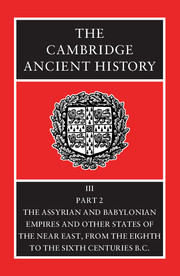Book contents
- Frontmatter
- Contents
- List of maps
- List of text-figures
- Preface
- PART I ASSYRIA AND BABYLONIA
- 21 Babylonia in the shadow of Assyria (747–626 B.C.)
- 22 Assyria: Tiglath-Pileser III to Sargon II (744–705 B.C.)
- 23 Assyria: Sennacherib and Esarhaddon (704–669 B.C.)
- 24 Assyria 668-635 B.C.: the reign of Ashurbanipal
- 25 The fall of Assyria (635–609 B.C.)
- 26 Assyrian civilization
- 27 Babylonia 605–539 B.C.
- 28 The culture of Babylonia
- PART II THE EASTERN MEDITERRANEAN AND THE BLACK SEA
- Chronological Table
- Note on The Calendar
- BIBLIOGRAPHY
- Index
- Map 11: Phoenician and Punic sites in Spain
- Map 13: Scythia
- Map 14: Thrace
- References
26 - Assyrian civilization
from PART I - ASSYRIA AND BABYLONIA
Published online by Cambridge University Press: 28 March 2008
- Frontmatter
- Contents
- List of maps
- List of text-figures
- Preface
- PART I ASSYRIA AND BABYLONIA
- 21 Babylonia in the shadow of Assyria (747–626 B.C.)
- 22 Assyria: Tiglath-Pileser III to Sargon II (744–705 B.C.)
- 23 Assyria: Sennacherib and Esarhaddon (704–669 B.C.)
- 24 Assyria 668-635 B.C.: the reign of Ashurbanipal
- 25 The fall of Assyria (635–609 B.C.)
- 26 Assyrian civilization
- 27 Babylonia 605–539 B.C.
- 28 The culture of Babylonia
- PART II THE EASTERN MEDITERRANEAN AND THE BLACK SEA
- Chronological Table
- Note on The Calendar
- BIBLIOGRAPHY
- Index
- Map 11: Phoenician and Punic sites in Spain
- Map 13: Scythia
- Map 14: Thrace
- References
Summary
Many topics have been lightly touched upon in the preceding chapters which merit special attention, and it is the purpose of this chapter to fulfil that need. A synthesis of our knowledge of a given aspect of Assyrian civilization is full of lacunae and surmise, and I advise the reader of this now, for I have spared him endless repetitions of such phrases as ‘It would seem that’ or ‘Possibly so’. These topics are usually treated for Assyria and Babylonia together in secondary works, and I have therefore stressed some of the major contrasts with Babylonian civilization.
THE MONARCHY
The idea of monarchy was born with the emergence of the Assyrian state and the two grew to maturity together like twins. The seed for these developments may be found in the ancient city state of Ashur and its ruler who was called a vice-regent (išši' akku) of the city god Ashur. When Shamshi-Adad I captured this city state, he sought acceptance by the indigenous population of himself as the legitimate ruler and at the same time, by conquering other city states in the region and assuming the imperialistic title šarru (‘king’), dramatically altered the previous course of Ashur's history and set for its people and their heirs highly ambitious goals. The idea of an Assyrian state under an absolute monarch was conceived at that moment but lay dormant until the time of Ashuruballit I (1363–1328 B.C.), who not only won Assyrian independence but laid the foundations of an Assyrian nation and an Assyrian monarchy.
- Type
- Chapter
- Information
- The Cambridge Ancient History , pp. 194 - 228Publisher: Cambridge University PressPrint publication year: 1992
References
- 4
- Cited by

